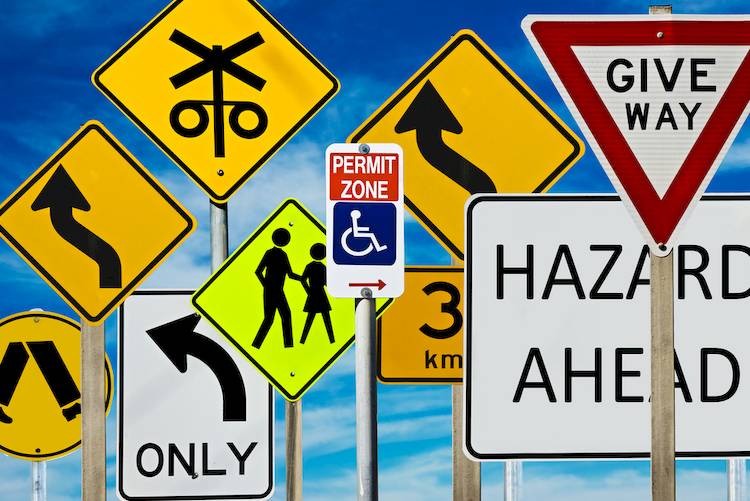

Driving in the state of Washington gives you a lot of great opportunities to see some of the country’s most beautiful natural sights. If you live in Washington or visiting and plan on doing any driving there, you should be familiar with the rules of the road in Washington.
General safety rules in Washington
All drivers and passengers in moving vehicles in Washington must wear seatbelts.
Children under the age of 13 must ride in the back seat. Children who are under eight years old and/or have not reached 4’9” tall must be secured in a child seat or booster seat. Children under 40 pounds must also use a booster seat, and infants and toddlers must be secured in appropriate child seats.
You must stop for school buses with flashing red lights, whether you are approaching from behind or in front. The only exception to this rule is when you’re traveling in the opposite lane on a highway with three or more marked traffic lanes or on a highway that’s divided by a median or other physical barrier.
As in all other states, you must always yield to emergency vehicles when they have their lights flashing. Whatever direction the emergency vehicle is approaching from, you must do everything you can to clear the road and let them pass. Pull over if necessary, and never enter an intersection when an emergency vehicle is approaching.
Pedestrians will always have the right of way when in a marked crosswalk. Motorists must always yield to pedestrians before entering a roadway from a private drive or alley. Be aware that pedestrians may be crossing when you are making a turn at an intersection.
In Washington, bicyclists have the choice to ride in bicycle lanes, on the shoulder of roads, or on sidewalks. On sidewalks and in crosswalks, they must yield to pedestrians and must use an audible signal before passing a pedestrian. Motorists should yield to bicyclists in bicycle lanes when turning and should pass with a safe distance between the vehicle and the bicycle.
When you encounter yellow flashing traffic lights in Washington, it means that you should slow down and proceed with caution. When the flashing lights are red, you should stop and yield to traffic, pedestrians, and/or bicycles crossing your path.
Out of order traffic lights that aren’t flashing any color at all, should be treated as four-way stop intersections.
All Washington motorcyclists must wear approved helmets whenever operating or riding a motorcycle. You can get a motorcycle endorsement for your Washington driver’s license if you take a motorcycle safety endorsement course or you pass a knowledge and skills test provided by an approved testing facility.
Keeping everyone safe on the roads in Washington
Passing on the left is legal in Washington whenever you see a dashed yellow or white line between lanes. It is illegal to pass in any area where you see a “Do Not Pass” sign and/or if you see a solid line between lanes. Passing in intersections is also prohibited.
After stopping at a red light, you may make a legal right on red unless there is a sign prohibiting it.
U-turns are legal in Washington wherever there is not a “No U-Turns” sign, but you should never make a U-turn at a curve or anywhere that you cannot see at least 500 feet in each direction.
Four-way stop intersections in Washington operate the same way that they do in other states. The first person to arrive at the intersection will go first after making a complete stop. If multiple drivers arrive at the same time, the driver on the right will proceed first (after stopping), followed by the driver to their left, and so on.
Blocking intersections is never legal in the state of Washington. Do not try to move through an intersection if you cannot get all the way through and clear the roadway for cross traffic.
When entering a freeway, you may encounter ramp-metering signals. These look like traffic lights, but are usually only composed of a red and green light, and the green signal is very short. These are placed at on-ramps to allow one car at a time to enter the freeway and merge with traffic.
High occupancy vehicle (HOV) lanes are reserved for vehicles with multiple occupants. They’re marked by white diamonds and signs that indicate how many occupants your vehicle must have to qualify for the lane. An “HOV 3” sign requires vehicles to have three occupants to travel in the lane.
DUIs, accidents, and other rules for Washington drivers
Driving under the influence (DUI) in Washington refers to driving with a BAC (blood alcohol content) above the legal limit for alcohol and/or THC.
If you’re involved in an accident in Washington, move your vehicle out of the roadway if you can, exchange contact and insurance information with the other driver(s), and wait for the police to arrive at or near the site of the accident.
You may use radar detectors in your personal passenger vehicle in Washington, but they may not be used in commercial vehicles.
Vehicles registered in Washington must have valid front and rear license plates.



